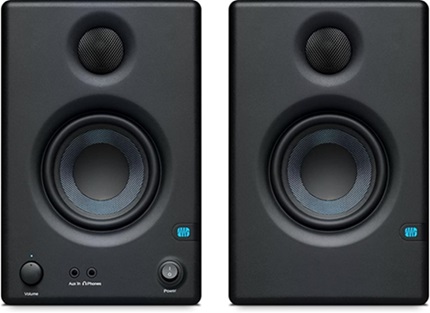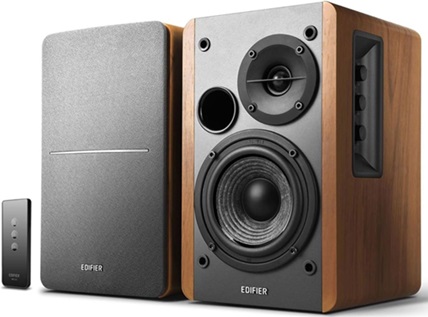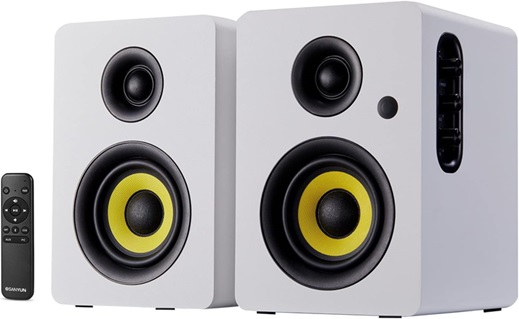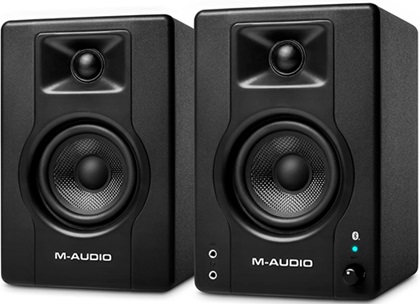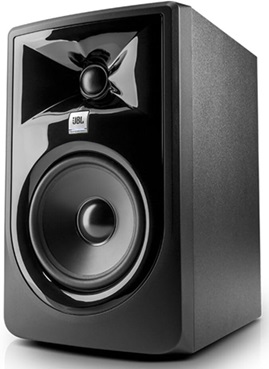Having a high-quality audio system that can reproduce your mixes is crucial while making music. That means selecting the best studio monitor is an important decision for you as a music producer. But how do you pick the right one? You must look at various aspects to ensure that they comply with your unique requirements for precise audio reproduction.
Check Out These must-have Features:
- Frequency Response: The frequency response of studio monitors ranges from 40Hz – 20kHz. Look for models with a flat and extended frequency response for accurate sound reproduction.
- Room Acoustics and Size: Consider the size and acoustics of your studio space. Some studio monitors are meant for nearfield use in small rooms, whilst others are classified as midfield or main monitors for bigger settings.
- Connection Options: Studio monitors include many connection choices, such as XLR, TRS, or RCA inputs. Make sure the monitors you choose have the correct inputs for your audio interface or other equipment.
- Digital Signal Processing (DSP): Get a model with DSP capabilities that allow room calibration and tweaks to adapt the sound to your specific studio setting.
Outline
ToggleBest Studio Monitors Table
| Product Name | Connectivity Technology | Output Power | Woofer and Tweeter Size | Buy Now |
|---|---|---|---|---|
| PreSonus Studio Monitor | RCS, Auxiliary, TRS | 25 Watts | 3.5 " and 1" | Check On Amazon |
| Edifier Studio Monitor | RCA | 42 Watts | 6" and 0.5 " | Check On Amazon |
| Sanyun Studio Monitor | Auxiliary, USB, Optical, Bluetooth 5.0, Coaxial, 6.35mm TRS | 80 Watts | 4 " and 0.9 " | Check On Amazon |
| M-Audio Studio Monitor | Bluetooth | 120 Watts | 3.5 " and 1" | Check On Amazon |
| JBL Professional Studio Monitor | XLR | 82 Watts | 2.4 " and 0.4 " | Check On Amazon |
Best Studio Monitors Reviews
1. PreSonus Studio Monitor
Why it made the cut: Studio-quality sound, versatile connectivity, compact design.
The PreSonus Studio Monitors are highly recommended for a variety of applications such as multimedia, gaming, and studio recording. Equipped with 3.5-inch woven composite drivers and 1″ ultra-low-mass silk-dome tweeters, they deliver deep bass and well-balanced high-frequency audio. Their standout feature lies in their acoustic tuning, ensuring exceptional sound quality regardless of room acoustics.
Additionally, they come with the Studio One Prime and Studio Magic plug-in suite, valued at over $1000 in music production software. Their front panel is designed for convenience, offering a stereo aux input for smartphones, a headphone jack, and user-friendly volume/power controls. Powered by 50-watt Class AB amplification, these monitors provide ample volume and headroom for nearfield monitoring.
Specifications:
- High-quality sound tuning for excellent audio performance
- Comes with Studio One Prime and Studio Magic plug-in suite
- Equipped with 3.5-inch woven composite drivers and 1-inch ultra-low-mass silk-dome tweeters
- Easy-to-use front panel controls for convenience
- Powered by 50 watts of Class AB amplification
- Features a professional-grade industrial design for studio-quality aesthetics.
Pros:
- Clear sound quality
- Convenient front panel controls
- Included software for music production
- Versatile connectivity options
Cons:
- Not ideal for heavy bass genres
2. Edifier Studio Monitor
Why it made the cut: Retro design meets modern audio quality.
The Edifier R1280T blends a vintage look with contemporary audio engineering to deliver outstanding sound quality in a small form factor. Boasting 42 watts RMS of power, they offer authentic sound reproduction through their 13mm silk dome tweeter and 4-inch full-range driver. Whether you’re enjoying music, watching movies, or gaming, these speakers offer an immersive audio experience.
Equipped with two AUX inputs and on-speaker controls for volume, bass, and treble, they offer convenient connectivity and versatility. The MDF wood construction with a classic wood finish adds a touch of sophistication to any room, while the included remote control enables easy adjustment of volume and muting from a distance.
Specifications:
- Retro design with modern audio quality
- Adjustable volume, bass, and treble controls
- Dual AUX inputs for versatile connectivity
- Compact size ideal for bookshelves or desks
- 42 Watts RMS power output for room-filling sound
- High-quality MDF wood construction
- 2-year warranty for peace of mind
Pros:
- Natural sound reproduction
- Easy setup and installation
- Stylish retro design
- Convenient remote control included
Cons:
- Not suitable for deep bass enthusiasts
3. Sanyun Studio Monitor
Why it made the cut: Versatile dual-mode functionality.
For those seeking both affordability and performance, the SW206 by Sanyun is an excellent choice. These studio monitors come highly recommended for their ability to handle both studio monitoring and high-fidelity listening needs effortlessly. With the ability to switch between two modes seamlessly, they provide flexibility for both content creators and music enthusiasts alike.
These speakers are meticulously crafted with attention to detail, featuring a 4-inch carbon fiber speaker unit paired with a 25mm silk dome tweeter, ensuring exceptional sound quality across the entire frequency range. They maintain a neutral frequency response, ensuring precise sound reproduction without any unwanted alterations. With a variety of connectivity options including optical, coaxial, aux, Bluetooth 5.0, and USB with a 24-bit DAC, they can easily connect to a wide range of devices. Additionally, the inclusion of a 6.35mm TRS balanced input interface allows for effortless integration with professional equipment such as mixing consoles and amplifiers.
Specifications:
- Studio Monitor & HiFi Mode
- 4-inch Carbon Fiber Speaker
- 25mm Silk Dome Tweeter
- Balanced Input Interfaces
- Various Connection Methods
- 80W Rated Output Power (HIFI Mode)
- 60W Rated Output Power (Monitor Mode)
- AC100-240V/50-60HZ Power Supply
- 80Db SPL
- Frequency Range up to 20 Hz-20 KHz
- THD+N: ≤1% at maximum volume output
Pros:
- Versatile dual-mode functionality
- Exceptional sound performance with carbon fiber speakers
- Wide range of connectivity options
- Sleek design with remote control convenience
Cons:
- Volume knob issues with USB connection
4. M-Audio Studio Monitor
Why it made the cut: Affordable, versatile studio monitors with Bluetooth.
An economical, user-friendly, and compact solution is the M-Audio BX3BT 3.5″ Studio Monitors. These speakers are ideal for upgrading your studio setup without straining your budget.These compact speakers deliver a robust performance with 120W of bi-amplified power.
Featuring a durable MDF cabinet and bass reflex design, they produce deep and immersive sound. Whether you’re composing music or working on multimedia projects, the BX3BT ensures precise audio playback that enhances your creative process. With its contemporary design and versatile connectivity features, these studio monitors provide exceptional sound quality.
Specifications:
- 120W Bi-Amplified Power
- MDF Cabinet with Bass Reflex Design
- 3.5″ Woofer and 1” Silk Dome Tweeter
- Bluetooth and Auxiliary Connectivity
- EQ Controls and Left/Right Speaker Positioning
- MPC Beats Software Included
Pros:
- Affordable price point.
- Versatile connectivity options, including Bluetooth.
- Clear and precise sound reproduction.
- Sleek and modern design.
Cons:
- Some users report issues with startup ease.
5. JBL Professional Studio Monitor
Why it made the cut: Legendary JBL performance for every studio.
The JBL Professional 305P studio monitor is designed to significantly improve your studio audio experience. Renowned for its exceptional performance, this monitor incorporates advanced technologies to deliver outstanding sound quality in any studio setting.Equipped with the patented Image Control Waveguide, this monitor provides precise imaging and a wide sweet spot, enabling immersive recordings with depth and ambiance.
Additionally, the patented Slip Stream™ low-frequency port guarantees excellent bass performance at all volume levels, enhancing your listening experience with deep and precise bass tones. Its sleek, modern design adds a stylish touch to any studio setup, and its compact size and compatibility with magnetically sensitive equipment make it suitable for various production environments.
Specifications:
- Patented Image Control Waveguide
- Next-Generation JBL Transducers
- Patented Slip Stream™ Low-Frequency Port
- Dual Integrated Custom Class-D Amplifiers (82W total)
- Maximum SPL: 94dB/108dB (continuous/peak)
- Approved for Use Near Magnetically Sensitive Equipment
Pros:
- Exceptional sound quality and clarity.
- Impressive bass extension and stereo imaging.
- Compact and sleek design.
- Reliable and durable construction.
Cons:
- Power may not be sufficient for larger studios.
Factors To Consider When Choosing The Best Studio Monitors
When Selecting studio monitors for your setup, there are a few key things to keep in mind to make sure you get the best sound quality:
1. Connectivity Technology
Studio monitors offer various connectivity choices such as XLR, TRS, RCA, and occasionally Bluetooth. Your selection depends on your audio interface and other equipment. XLR and TRS connections are prevalent in professional studio setups due to their balanced signal transmission, reducing interference and noise.
- Analog XLR and TRS Inputs: These are common in professional studio setups, offering a balanced connection for low interference and high-quality audio transmission.
- Digital Inputs: For those working with digital audio sources, monitors with digital inputs (e.g., SPDIF, AES/EBU) can simplify your setup and maintain high audio fidelity.
- Bluetooth Connectivity: Some studio monitors now feature Bluetooth, allowing wireless music streaming from smartphones and other Bluetooth-enabled devices. While convenient, it’s crucial to ensure that the wireless connection doesn’t compromise audio quality.
2. Output Power
The output power of studio monitors dictates their capacity to produce sound at different volumes without distortion. Higher wattage generally means louder sound and better performance, but it’s vital to factor in your studio space’s size. Lower wattage monitors may suffice for smaller rooms, while larger spaces may necessitate more powerful options.
3. Woofer and Tweeter Size
The size of the woofer and tweeter significantly influences the frequency response and overall sound quality of studio monitors. Larger woofers typically yield deeper bass frequencies, whereas smaller tweeters reproduce higher frequencies with greater accuracy. Choosing a monitor with a well-balanced combination of woofer and tweeter sizes ensures accurate sound reproduction across the entire frequency spectrum.
4. Speaker Type
Studio monitors are available in various speaker setups, including 2-way, 3-way, and coaxial designs. 2-way monitors consist of a woofer and tweeter, while 3-way monitors incorporate a mid-range driver for enhanced frequency separation. Coaxial monitors integrate the tweeter within the woofer, resulting in a more focused soundstage and improved imaging. Your choice of speaker configuration depends on your specific monitoring requirements and preferences.
5. Frequency Response
The frequency range of studio monitors determines the breadth of frequencies they can accurately reproduce. A wider frequency range guarantees that you can perceive all the subtleties in your audio recordings, from deep bass to crisp highs. Opt for monitors with a flat frequency response to ensure your mixes translate well across different playback systems.
6. Mounting Type
Studio monitors are available in various mounting configurations, including floor-standing, desktop, and wall-mounted choices. Your selection depends on your studio layout and personal preferences. Floor-standing monitors suit larger studios with ample space, while desktop and wall-mounted options are more appropriate for smaller setups or where space is limited.
Studio Monitors – FAQs
Ans: Studio monitors offer precise audio playback, allowing you to hear every detail in your recordings. They help ensure your mixes translate well to other playback systems.
Ans: Studio monitors are engineered for accuracy and flat frequency response, whereas regular speakers may emphasize certain frequencies for a more pleasing sound.
Ans: The size of studio monitors depends on your room size and personal preference. Larger monitors typically offer deeper bass response, while smaller ones may be more suitable for smaller spaces.
Ans: Some studio monitors have built-in amplifiers (active monitors), while others require external amplification (passive monitors). Active monitors are generally more convenient and often offer better performance.
Ans: While studio monitors excel in accuracy, they may not provide the same “hyped” sound as consumer speakers. However, many people enjoy using them for critical listening due to their detailed reproduction.
Ans: Near-field monitors are designed for listening at close range, typically within a few feet, ideal for small studio spaces. Far-field monitors are intended for larger rooms and listening distances.
Ans: Yes, studio monitors are essential for home recording setups, ensuring accurate monitoring during recording, mixing, and mastering processes.
Ans: Key features to consider include frequency response, power rating, connectivity options, and built-in controls such as EQ adjustments.
Conclusion
Selecting the optimal studio monitors necessitates an understanding of your specific needs, financial constraints, and the dimensions of your studio. Each of the aforementioned studio monitors boasts distinctive attributes and functionalities, tailored to diverse requirements.
- For those seeking a cost-effective entry-level solution, the PreSonus Studio Monitor presents excellent value.
- Alternatively, for individuals requiring flexible connectivity and top-notch audio resolution, the Sanyun Studio Monitor SW206 emerges as a notable choice.
By assessing your studio’s requirements and your audio preferences, you can effectively elevate your audio production and listening encounters with the ideal studio monitor.

